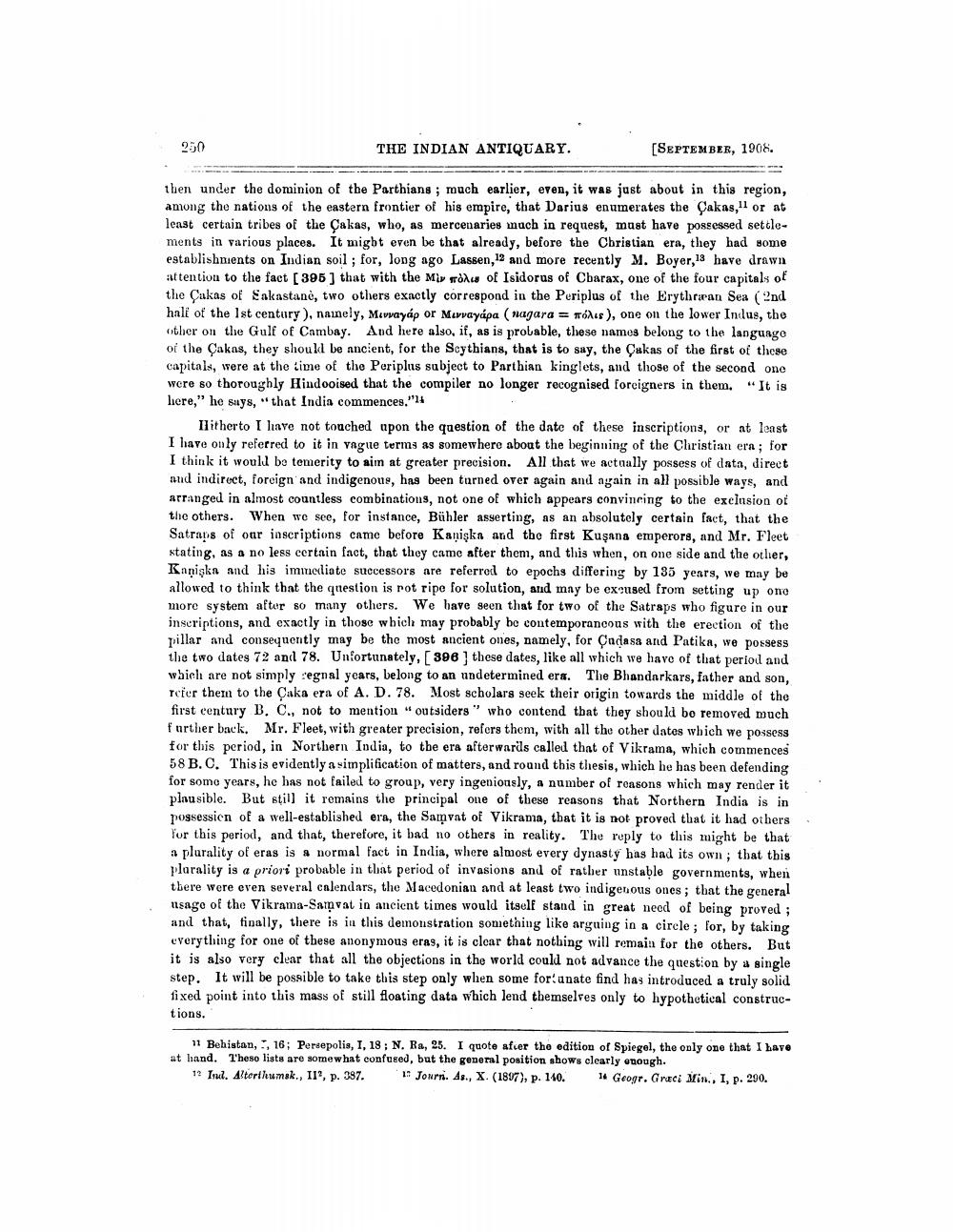________________
250
THE INDIAN ANTIQUARY.
[SEPTEMBER, 1906.
then under the dominion of the Parthians ; much earlier, even, it was just about in this region, among the nations of the eastern frontier of his empire, that Darius enumerates the Çakas, 11 or at lenst certain tribes of the Cakas, who, as mercenaries mach in request, must have possessed settlements in various places. It might even be that already, before the Christian era, they had some establishnients on Indian soil ; for, long ago Lassen, 12 and more recently M. Boyer, 18 have drawn attention to the fact [395 ) that with the My Tow of Isidorus of Cbarax, one of the four capitals of the Çukas of Sakastanė, two others exactly correspond in the Periplus of the Erythraean Sea (2nd hall of the 1st century), nainely, Mevayáp or Morvayápa (nagara = blus), one on the lower Indus, the other on the Gulf of Cambay. And here also, if, as is probable, these names belong to the language of the Çakas, they should be ancient, for the Scythians, that is to say, the Çakas of the first of these capitals, were at the time of the Periplus subject to Parthian kinglets, and those of the second one were so thoroughly Hindooised that the compiler no longer recognised foreigners in them." It is here," he says, "that India commences,"l1
Ilitherto I lave not touched upon the question of the date of these inscriptions, or at least I have only referred to it in vaglie terms as somewhere about the beginning of the Christian ere ; for I think it would be temerity to ain at greater precision. All that we actually possess of data, direct and indirect, foreign and indigenous, has been turned over again and again in all possible ways, and arranged in almost countless combinations, not one of which appears convincing to the exclusion of the others. When we see, for instance, Bühler asserting, as an absolutely certain fact, that the Satraps of our inscriptions came before Kaniska and the first Kuşana emperors, and Mr. Fleet stating, as a no less certain fact, that they came after them, and this when, on one side and the other, Koniska and his immediate successors are referred to epochs differing by 135 years, we may be allowed to think that the question is not ripe for solution, and may be excused from setting up ono more system after so many others. We have seen that for two of the Satraps who figure in our inscriptions, and exactly in those which may probably be contemporaneous with the erection of the pillar and consequently may be the most ancient ones, namely, for Çadasa and Patika, we possess the two dates 72 and 78. Unfortunately, [396 ) these dates, like all which we have of that period and which are not simply regnal years, belong to an undetermined ers. The Bhandarkars, father and son, refer them to the Çaka era of A. D. 78. Most scholars seek their origin towards the middle of the first century B. C., not to mention "outsiders " who contend that they should bo removed much further back. Mr. Fleet, with greater precision, refers them, with all the other dates which we possess for this period, in Northern India, to the era afterwards called that of Vikrama, which commences 58 B. C. This is evidently a simplification of matters, and round this thesis, which he has been defending for some years, he has not failed to group, very ingeniously, a number of reasons which may render it plausible. But still it remains the principal one of these reasons that Northern India is in possession of a well-established era, the Samvat of Vikrama, that it is not proved that it had others Yor this period, and that, therefore, it bad no others in reality. The reply to this might be that a plurality of eras is a normal fact in India, where almost every dynasty has had its own; that this plarality is a priori probable in that period of invasions and of ratber unstable governments, when there were even several calendars, the Macedonian and at least two indigenous ones; that the general usage of the Vikrama-Satņvat in ancient times would itself stand in great need of being proved ; and that, finally, there is in this demonstration something like arguing in a circle ; for, by taking everything for one of these anonymous eras, it is clear that nothing will remain for the others. But it is also very clear that all the objections in the world could not advance the question by a single step. It will be possible to take this step only when some fortunate find has introduced a truly solid fixed point into this mass of still floating data which lend themselves only to hypothetical constructions.
11 Behistan, , 16; Persepolis, I, 18; N. Ra, 25. I quote after the edition of Spiegel, the only one that I have at hand. These lists are somewhat confused, but the general position shows clearly enough.
12 Iul. Alterthumsk., II, p. 397. 1 JONrr. As., X. (1897), p. 140. 14 Geogr. Greci Min., I, p. 290.




